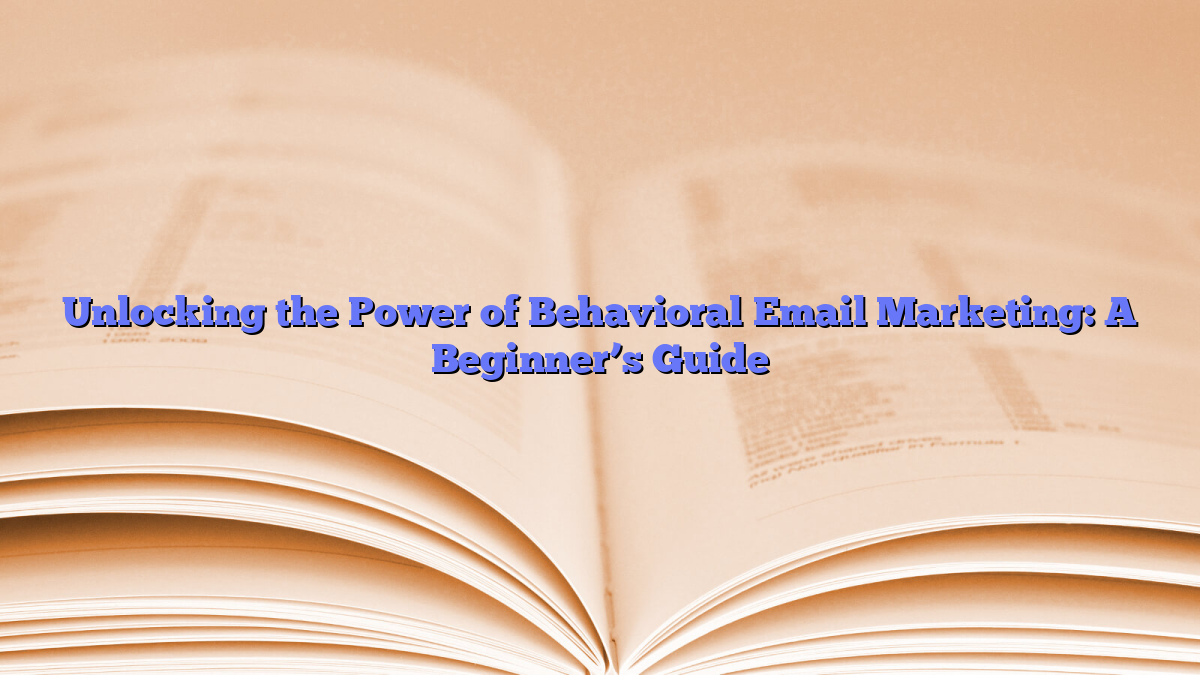Digital Marketing
Unlocking the Power of Behavioral Email Marketing: A Beginner’s Guide
Behavioral email marketing is a powerful tool that allows businesses to connect with their audience in a more targeted and personalized way. By leveraging data on a user’s behavior and interactions with your brand, you can send tailored email campaigns that are more likely to resonate with recipients and drive engagement. In this beginner’s guide, we will explore the basics of behavioral email marketing and how you can harness its power to grow your business.
Understanding Behavioral Email Marketing
Behavioral email marketing is all about using customer behavior data to send targeted and relevant emails. This can include a variety of different actions, such as website visits, email opens, link clicks, purchases, and more. By tracking and analyzing these behaviors, you can gain valuable insights into your audience’s interests, preferences, and intent, which can then be used to create personalized email campaigns.
One of the key benefits of behavioral email marketing is that it allows you to send the right message to the right person at the right time. By focusing on the recipient’s actions and preferences, you can deliver highly relevant content that is more likely to capture their attention and drive them to take the desired action. This can lead to higher engagement rates, increased conversions, and ultimately, a stronger ROI on your email marketing efforts.
Getting Started with Behavioral Email Marketing
If you’re new to behavioral email marketing, getting started can seem daunting. However, with the right strategies and tools, you can effectively leverage this powerful marketing tactic to drive results for your business. Here are some steps to help you get started:
1. Identify Your Goals and Audience
Before diving into behavioral email marketing, it’s important to clearly define your goals and understand who your target audience is. What specific actions or behaviors do you want to track? What kind of data do you need to collect to better understand your audience? By outlining your goals and audience, you can effectively tailor your email campaigns to deliver the right message to the right people.
2. Capture and Leverage Customer Data
Next, you’ll need to implement tools and strategies to capture and leverage customer behavior data. This can include using tracking pixels, cookies, and other technologies to gather information on website visits, email interactions, and more. By effectively capturing and analyzing this data, you can gain insights into your audience’s behaviors and preferences, which can then be used to inform your email marketing efforts.
3. Create Segmented Email Lists
Segmentation is a key aspect of behavioral email marketing. By dividing your email list into smaller, targeted segments based on customer behaviors and preferences, you can send highly personalized and relevant emails to each group. This can help improve open rates, click-through rates, and overall engagement with your campaigns.
4. Personalize Your Email Content
With the data you’ve collected, you can create personalized email content that speaks directly to each recipient’s interests and actions. This can include recommending products based on past purchases, sending targeted promotions based on website visits, and more. The more personalized and relevant your emails are, the more likely they are to drive engagement and conversions.
5. Test and Optimize Your Campaigns
As with any marketing strategy, it’s important to test and optimize your behavioral email campaigns to ensure they are effectively driving results. This can include A/B testing different subject lines, call-to-action buttons, and content variations to see what resonates best with your audience. By constantly refining your campaigns based on performance data, you can maximize their impact and ROI.
Conclusion
Behavioral email marketing is a powerful tool that allows businesses to connect with their audience in a more targeted and personalized way. By leveraging customer behavior data, you can send tailored email campaigns that are more likely to resonate with recipients and drive engagement. By following the steps outlined in this beginner’s guide, you can unlock the power of behavioral email marketing to grow your business and drive stronger results from your email marketing efforts.
FAQs
What types of behaviors can be tracked for behavioral email marketing?
There are a wide variety of behaviors that can be tracked for behavioral email marketing, including website visits, email opens, link clicks, purchases, and more. By capturing and analyzing this data, businesses can gain valuable insights into their audience’s interests and preferences.
How can I effectively leverage customer behavior data for my email campaigns?
To effectively leverage customer behavior data, businesses can create segmented email lists, personalize email content, and constantly test and optimize their campaigns based on performance data. By tailoring emails to recipients’ interests and actions, businesses can drive higher engagement and conversions from their email marketing efforts.
What are the key benefits of behavioral email marketing?
Behavioral email marketing allows businesses to send the right message to the right person at the right time, leading to higher engagement rates, increased conversions, and a stronger ROI on email marketing efforts. By focusing on customer behaviors and preferences, businesses can deliver highly relevant content that is more likely to capture recipients’ attention and drive them to take the desired action.
[ad_2]
